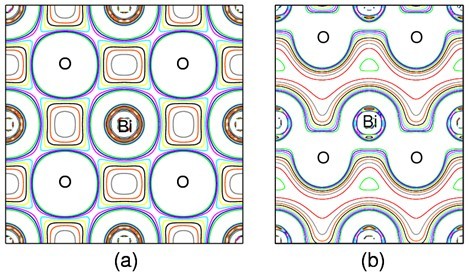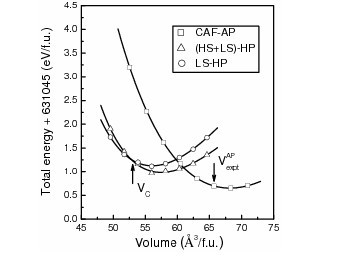Multiferroic materials, which have coexisting magnetism and ferroelectricity, are of great technological and fundamental importance. Researchers from the Key Laboratory of Materials Physics, Institute of Solid State Physics, Chinese Academy of Sciences, Hefei, China have sought the origin of the giant tetragonal ferroelectric distortion and the nature of the pressure-induced spin-state transition in the potentially multiferroic material BiCoO3. The present study, in strong contrast to some recent works, provides an insight into this potentially multiferroic material.
BiCoO3 was recently synthesized by high-pressure (HP) technique and it has been suggested to be a promising multiferroic material by Uratani et al. and by Ravindran et al. through first-principles Berry-phase calculations. BiCoO3 has a giant tetragonal lattice distortion of c/a = 1.27 with remarkable off-center atomic displacements. It was proposed that the giant tetragonal distortion originates from the lifting of the orbital degeneracy of the high spin (HS) (S =2) Co3+ ions and is stabilized by the subsequent xy-type ferro-orbital ordering. Note that orbital degenerate transition-metal oxides quite often display an orbital ordering (OO) but ferroelectric (FE) materials from them are rare as ferroelectricity and magnetism seem to, and actually do, in
most cases, exclude each other. Therefore, the proposed mechanism for the giant FE distortion does not appear to be straightforward. Note also that controversial spin states, both low-spin (LS) and intermediate-spin (IS) (S = 1), were suggested for the HP phase.
This work describes the attempts of Dr. Jia and Prof. Zeng et. al., in cooperation with Prof. Wu from Germany and Prof. Lin from Hong Kong, to find the origin of the giant tetragonal FE distortion in the ambient phase of BiCoO3. They have identified the nature of the pressure-induced spin-state transition, using two sets of configuration-state-constrained generalized gradient approximation plus Hubbard U (GGA+U) calculations. Their results show that the giant tetragonal distortion is driven by a strong Bi-O covalency (rather than by the aforementioned lifting of orbital degeneracy) and is further stabilized by a xy-type OO of the HS Co3+ ions. Moreover, they find that the pressure-induced spin-state transition is via a mixed HS-LS state, and that the transition would be complete upon a large volume decrease of about 20% (under about 8 GPa). The mixed HS-LS state accounts well for the available experimental results.
This work has been published on Physical Review B ,2011, 83, 174433 and released on Chinese Science Bulletin, 2011, 56, 2519.
This work was supported by the National Science Foundation of China, Grant No. 11004195, the Special Funds for Major State Basic Research Project of China (973), Grant No. 2007CB925004, the Knowledge Innovation Program of the Chinese Academy of Sciences, Grant No. KJCX2-YW-W07, and the Director Grants of Hefei Institutes of Physical Science, Chinese Academy of Sciences, and the Project HKUST3/CRF/09.

Charge density contour of BiCoO3 in the (100) plane of (a) the hypothetical ideal cubic structure and of (b) the LS relaxed structure with the experimental c/a ratio. The directional Bi-O covalency is apparent in (b).

E-V curves for the C-type AF state of BiCoO3 in the ambient phase, and for the mixed HS-LS state and the LS state under high pressures. The pressure-induced HS-LS transition is via a mixed HS-LS state, and that the transition would be complete upon a large volume decrease of about 20% (under about 8 GPa).